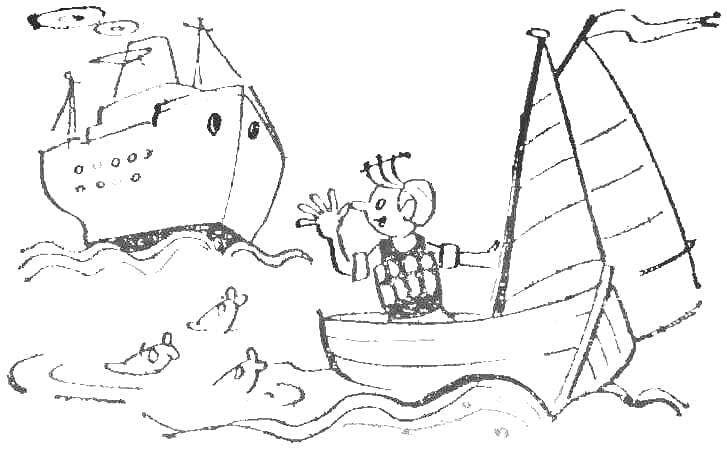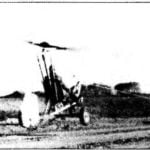 Rigging centerboard yacht “salute” consists of two sails (mainsail and headsail), mast, standing and running rigging. Mast are called wooden parts of weapons (“Salute” sail type “Guara” is the mast, boom and gaff). Standing rigging — forestay and shrouds, running — Director the jaw-Gardel (tackle for lifting Hafele), boom-mainsheet and the jib sheets (the ends that serve to control the sails). They are made usually of hemp rope (tight entourage or the special weave) thickness 10— 12 mm. Drawings of parts of the mast and their sizes are shown in figure 1.
Rigging centerboard yacht “salute” consists of two sails (mainsail and headsail), mast, standing and running rigging. Mast are called wooden parts of weapons (“Salute” sail type “Guara” is the mast, boom and gaff). Standing rigging — forestay and shrouds, running — Director the jaw-Gardel (tackle for lifting Hafele), boom-mainsheet and the jib sheets (the ends that serve to control the sails). They are made usually of hemp rope (tight entourage or the special weave) thickness 10— 12 mm. Drawings of parts of the mast and their sizes are shown in figure 1.
The quality of the cloth of which sails are made, and how they are made, depend on the propulsion and maneuverability of the yacht. The size and shape of the sails “Salute” is shown in figure 2.
The sequence of manufacturing of sails: dekatirovka fabric (if the fabric is linen or cotton), production drawing, nesting, based on the width of the fabric; determination of the size of the pieces of cutting and breakdown in the joints; cutting and marking the pieces; smetana and check after smachivaniya; stitch special sewing machine “zigzag” major joints of the body of the sail; suspension device for forming and marking scatolin; trimming and filing of scatterin; line scatterin the sewing machine; marking and setting of bows, eyelets, laderman and krementsov.
Since sewing sails great art, will examine all of its operations. Dekatirovka — soaking the fabric in hot water with soap and subsequent drying. Cotton fabric dekatherms twice, three times flax. After the last Wysocki the fabric is thoroughly rinse.
Drawing cutting is performed on thick paper or thin cardboard in scale 1:5 — first in the form of a conventional four square (Grote) and triangle (jib), corresponding to the overall dimensions of the sails (Fig. 2). From the conventional rear foot (for the mainsail) and the front (for the sail) at a right angle the line to the top of the tack corner. This perpendicular will be renamed the first seam of the sail, everyone else must be parallel. Their distance from the first seam made to do equal to half the width of the available material. Here is laid and strochitsa so-called “false seam”, whose purpose is to give the sail more rigid and to prevent its uneven hood in operation (a wide piece of cloth with the hood to form “bags”, and the sail largely loses its aerodynamic qualities); the false seam is best to lay and stitch along the whole of the material before cutting. The individual pieces numbered in order (from the bottom up, from the first seam) and applied to each of them in accordance with the drawing “axis of sails” to properly combine items in the gumption.

Fig. 1. Mast and sensible things.
The mast is made from a pine bar section 65X65 mm, has a round shape throughout its length. The lower part (spurs) is a square 40X40 mm, the upper part (top) is closed round by a fungus of plywood 10 mm thick. Chicks oak, are fastened to the mast by two through bolts M6. The gaff — two pine sticks (blank section 65X25 mm); in the processing of it is attached a spindle-shaped form in accordance with Fig. Whiskers are attached with two through bolts M6. The geek doing the same (blank section 65X30 mm).

Fig. 2. Sails, their cutting and design of the seams.
The left shows the staysail, right grog. A — a — seam No. 1, b — B — a false seam, the — In — connection “stocking” with a sail, G — G line scatolin, D — D — overlay laderman Bottom right shows the scan of a holder unit of the boom-sheet. The pulleys are made from brass or PCB; the width of the groove of the pulley shall be not less than the diameter of the boom-sheet.

Fig. 3. A device for forming the sails.

Fig. 4. Sensible things, swivel boom, centerboard and rudder.
As laid stitches on the body of the sail, shown in figure 2. When smachivanie panels their first sew one side, then the other, carefully powerdiva Unfiled edges lower edges. Gastrochef all the seams, it is necessary to remove a running thread and for fitting the sail first along (for the base), then across (on a duck). This will determine to a first approximation, how well managed to make sail, and pursue it “moulding” — giving the sail the most advantageous aerodynamic form. The latter is determined visually by the curvature and depth of the so-called “belly”, i.e., bending, which becomes a sail under wind pressure. Forming is performed on a simple device — a frame of thick boards (Fig. 3) that is installed on poles or stakes, at a height of 400-500 mm from the ground. Stretching the front leech of the sail along the Board B In and at the same time securing it with nails, a sail nailed to the corner of G and stretch along the Board of A—B, then fasten the last corner. Then edges are selected on a Board and fastened with small nails, making sure that the sail is properly sagged, forming a trough: steep Boards of the frame and smooth at the back foot. Without removing the sails with fixtures, perform trimming and filing of katarin, and trim the back foot at the circle line, which is shown in figure 2, on large flat ground (e.g., asphalt). Line satorin is running on the machine “zig-zag” sailing double seam (Fig. 2, G—G).
The following operation — proshivka reinforcing corner pads (bows) They are cut out of the same material as the sail, and put on all four corners of the grotto and three headsail. Bows are superimposed on the same side of the sail, which laid down the seams of the edging.
Laderman — pockets for the slats, giving the sail the cross-elasticity and shape — sewn on the lines indicated in the drawing as a “Latin axis”, on the one hand from the same material as the sail.
Eyelets taken are ready, they are workshops that manufacture leather goods. In a pinch you can punch in the part circular openings, neaten their loopy seam and secure with glue BF-6.
SETTING THE SAILS ON THE MAST
The grotto is attached to the first gafaw and the geek 5-mm bolts. tightening the halves of these elements of the mast. When you screed to apply glue, for example, BF-2 or epoxy. After this is in place the mast and it is put on the “stocking” of the grotto. Then set in place the forestay, shrouds and FAPs, used to hoist sails. The forestay and shrouds should be fitted vtupuyu to the mast took a strictly vertical position. You can then raise the gaff, gradually correcting “stocking” up. Securing the swivel of the boom and taking it the rear end of the sheet, choose the gaff and lay it vtupuyu FAP for a duck. (All this with complete calm, the wind does not interfere with the installation.) The sail needs to crack down and take the working position. It happens that the first time the sail is not getting as expected: pull; in this case it is necessary to try different variants of fastening, tightening or loosening the bowline and “stocking”. “The sense of sails” is produced gradually as experience is gained, so the beginner it is useful to consult sailors.
Setting sail is easy. Selecting vtupuyu FAP, the sail pull the mainsheet on one side and ducks in this position, give to deal. Final “cover” of the sails takes place gradually, during a voyage.
EQUIPMENT SAILING YACHT MANAGEMENT
To learn how to sail a boat can every physically healthy person, but you must understand some questions of the theory. The boat moves forward under the action of wind power. If the wind is blowing from the stern and the sail works as a simple damper for the adoption of wind pressure — everything is clear: the boat goes where the wind blows. But as you know, on the boat you can walk almost against the wind, at an angle which is determined by the quality of the sails and the ship itself, as well as the art of steering. Why? Look carefully at the diagram of the forces acting on the sail (Fig. 5). When driving with the lateral or counter-lateral wind force it can be decomposed in three areas — movement, roll and drift. The ratio of these forces changes the position of the sails and rudder, used for steering to give the boat the desired course.

Fig. 5. The scheme of forces acting on a sailing ship.

Fig. 6. The scheme of implementation of the basic maneuvers of a sailboat and their names relative to the wind.
Driven us schemes (Fig. 6) shows a variety of the most frequently encountered in naval practice the evolution of sailing ships. They help future steering to master in a short time is not very complicated technique of sailing. The first practical lessons on the water should still be carried out with more experienced friends, when the wind is not more than 5 m/s and near the coast.
OUR OSVOD
Can PI to sailing, so that after each trip to stay dry? You can, if you use the experience of generations of sailors, are summarized in guidance and instructions. No, we will not force you to study thick tomes luminaries of the keel and the sails, but with an extract of the main provisions to meet just need.
As you probably know, there are two main turn — off “tack” and “jibe”. The existence of the third, too, you know, if not will be guided in the future by the following paragraphs of our statement (we are Talking about turn “overkill” — procedia research Institute of the ship keel up):
§ 1. The rescue of drowning — the handiwork of drowning! The validity of this statement is especially acute on the yacht, where, in addition to the crew, to save the crew no one. Therefore, even standing at the dock the boat should be in the lifejacket.
§ 2. The wind when lifting the sails can play a cruel joke with you and demonstrate the same third turn, which was mentioned above, unless you have the courage and look him straight in the face, i.e. not turning the boat nose to wind.
$ 3. To stand up while driving and go from place to place is not recommended, other members of the crew can be regarded as the intention of forcibly redeem them and to guarantee in that case your immunity we do not undertake.
§ 4. Don’t force the team to keep the yacht on an even keel, putting it all on the windward Board when the squally wind; better to ease off the mainsheet, losing some speed, rather than the sudden weakening of the wind to unload the entire crew into the water.
§ 5. Remember, sheets, and halyards confused when their untangling neither the time nor the energy. Therefore, it is best to pre-assemble them in a neat Bay.
§ 6. Never fix the tips on ducks and nails dead (protracted) loop, and only free turns (rpm): wind overturns a sailboat faster than this untied loop. This usually leads to the fact that it lives up to its name.

§ 7. On the go keep the sheets in his hands, and do not tie them for duck anybody in a head will not come to bind the wheel to the car.
§ V. If the pond is deep and the water is cold, it is much better to securely fasten heavy objects to learn more than one instruction — to raise sunken vessels, which incidentally, we are not going to publish in upcoming issues of our magazine.
§ 9. “Overkill” — this is the twist that it is easier in the fresh wind when you turn the wind, that is, when the wind is blowing from the stern.
§ 10. To give advice to the captain is to advise the doctor; in particular this applies to the passengers.
§ 11. Remember that the qualifications of the steering is determined primarily by knowledge and experience, and not a suit under the “sea wolf.”



